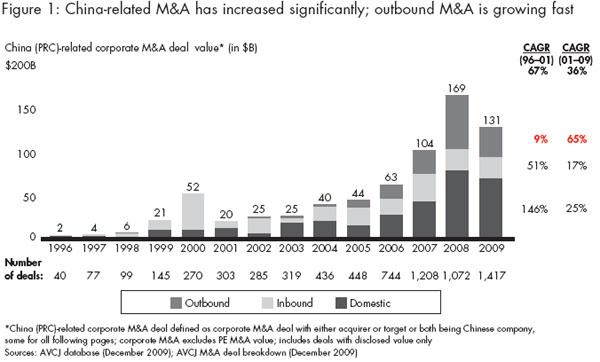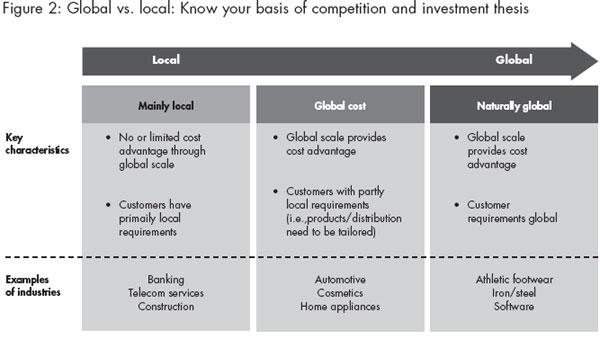China is becoming a key player in a game that it's just beginning to learn how to play. The country's explosive economic growth has spurred a corresponding boom in mainland companies pursuing expansion opportunities overseas through mergers and acquisitions (M&A), joint ventures, partnerships or organic growth. Chinese firms seeking access to other markets are discovering that a global expansion strategy is just as critical as it is for foreign companies trying to win in China. Even as the financial crisis hit in 2009, the value of deals involving Chinese companies making overseas acquisitions totaled $35.9 billion. As recently as 2004 it was only $3.5 billion.
Cash-rich Chinese firms are in a strong competitive position to make inroads into foreign markets. They've been relatively insulated from the financial crisis while many hard-hit Western companies are trying to unload struggling businesses and assets that have lost value. Mining, telecom, utilities and financial services topped the list for outbound M&A deals in 2008 and 2009. Typically, the deals are small, with minority stakes totaling just $50 million or less. But several multibillion-dollar deals are in the works or completed, including the $7.7 billion acquisition last year of Canada-based Addax Petroleum by Sinopec International Petroleum Exploration and Production Corporation (SIPC), a subsidiary of China Petrochemical Corp, and Zhejiang Geely Holding's $1.8 billion purchase of Ford Motor's Volvo division. With growing demand for raw materials and energy, these sectors will continue to pursue M&A deal making.
But Chinese companies are discovering that expanding into foreign markets is tricky. And they aren't alone. Worldwide, we've found that M&A efforts often fail to deliver the intended value and the stakes are even higher for companies that lack experience in M&A. A Bain & Company global survey of 750 companies showed that 55 percent - more than half - of the acquiring companies' stock failed to outperform the market one year after deals were announced.
 When Shanghai Automotive Industry Corporation (SAIC) won a heated takeover battle in 2004 for a nearly 50 percent stake of Ssangyong, it was the first acquisition by a mainland company of a foreign car manufacturer, with the potential of SAIC and Ssangyong complementing each other's businesses. But SAIC encountered a number of challenges, including an inability to get control of Ssangyong's operations and labor unions.
When Shanghai Automotive Industry Corporation (SAIC) won a heated takeover battle in 2004 for a nearly 50 percent stake of Ssangyong, it was the first acquisition by a mainland company of a foreign car manufacturer, with the potential of SAIC and Ssangyong complementing each other's businesses. But SAIC encountered a number of challenges, including an inability to get control of Ssangyong's operations and labor unions.However, some seasoned acquirers are getting it right. We've found that they start slow and small, gaining experience and confidence with domestic acquisitions before expanding globally. Winners often monitor the growth of acquisition targets for years before making an offer. They focus on how the deal could take full advantage of synergies for both parties. Winning acquirers understand that to excel, they have to attract and retain top talent.
ChemChina (China National Chemical Corp) became the mainland's No. 1 chemical conglomerate by following that path. After more than 100 domestic acquisitions, ChemChina, on its own or through its Blue Star subsidiary, then targeted three major foreign firms - Adisseo and Rhodia in France and Qenos in Australia. The deals helped catapult ChemChina onto the global stage, giving it the technology, management skills, capital and market access required to become a multinational player.
As the pace of global expansion by mainland firms accelerates, Chinese businesses need to learn quickly several important lessons to replicate the success of companies like ChemChina.
Rule 1: Know which approach works best for you
Don't assume conventional M&As are your only options.
While M&As are the major growth strategy, companies often learn the ropes by forming partnerships and joint ventures in foreign markets. That approach gives them insights into the difficulties of foreign expansion and crucial experience without as large a financial commitment. Advantages include using a partner's manufacturing facilities, piggy-backing off their already well-established brands, sales and distribution networks and talent. While joint ventures are less risky than acquisitions, they involve their own special hurdles.
The challenge is to know why you want a partner, what the "win-wins" are for both companies and how to tackle the cross-cultural challenges. Take Haier, now a leading global white-goods manufacturer. It is learning how to use partnerships with US players such as General Electric for joint product development and reciprocating by providing regional access in the Chinese market through Haier's distribution partners.
Since 2008, Alibaba.com, the global leader in e-commerce for small business, has used a joint venture with Japan's telecommunications giant, Softbank, to open up new opportunities in the Japanese marketplace. It gave Alibaba.com access to Softbank's talent and sophisticated knowledge of the Japanese market. Now the two companies are in talks to form a partnership that would jointly promote e-commerce between China and Japan.
Rule 2: Know why you're acquiring
Understand the basis of competition, then create an investment thesis.
One of the best ways to avoid disastrous acquisitions is to articulate clearly why buying a business will make your company more valuable. Even in good times, many companies don't understand the importance of an investment thesis. When we surveyed successful acquirers, we found that about 80 percent of successful transactions were based on a clear investment thesis. For failed deals, it was about 40 percent. Too often, companies haven't pinpointed the best opportunities for value creation as well as assessed the risks.
In good times and bad, a winning acquisition strengthens a company's basis of competition such as its cost position, brand strength or customer access and loyalty. All were goals of the IBM acquisition, which helped Lenovo achieve global scale, build a global brand and gain access to leading-edge technology in what was the fastest growth segment of the time.
Amid economic turbulence outside of China, it's especially important to keep updating the valuations of potential targets. Many companies are relatively cheap in a downturn because their shares have plunged. But some companies are cheap for good reason, and the adage that you get what you pay for often applies.
And update the target list based on changing market variables. The future business climate is likely to be more tightly regulated, less leveraged and more risk averse. Once-successful business models may no longer work. Onetime market leaders may be permanently compromised. Yet you may want to add businesses that you think are likely to thrive in a different environment.

Rule 3: Know which deals you should close
Ask and answer the few questions that test your investment thesis.
Identifying potential acquisition targets and winnowing them to one or two best choices requires discipline. Instead of hastily reacting to acquisition targets as they come on the market, seasoned deal makers know their basis of competition and are constantly thinking about the types of deals they should pursue. Their M&A teams create a pipeline of priority targets, each with a customized investment thesis and then cultivate a relationship with each one. As a result, they can quickly close a deal.
Because they know what they want to achieve with the acquisition, they're often willing to pay a premium or act faster than rivals.
But before closing a deal, winners overinvest in due diligence. In cross-border deals, rigorous due diligence is even more critical to head off problems before a purchase is completed and requires extra attention. The process should start by zeroing in on potential roadblocks such as regulatory or political issues. To develop an insider's point of view, companies can tap their existing networks or customers and dispatch an advance team to review the target firm thoroughly.
Rule 4: Know where you need to integrate first
Prioritize getting at the key sources of value quickly.
Our research shows that cross-border deals carry a similar rate of success as domestic deals, but integration typically is more complex. The unique challenges include tailoring the integration thesis to each region's circumstances, tackling actual and perceived cultural differences, considering geographically dispersed operations and stakeholders as well as complex legal and regulatory requirements that can derail the integration.
To boost the odds of success, acquirers need to:
Identify the best sources of synergies and prioritize them
Ensure that the integration process isn't overly complex
Be able to make decisions quickly so that critical milestones aren't missed
Provide strong leadership of the integration process
Understanding whether deals are to boost "scope" or "scale" is vital. Chinese apparel maker Youngor Group Ltd's acquisition of US based Kellwood Co's Smart Shirts business is largely a scale deal designed to expand a core business, as opposed to a scope deal aimed at expanding into adjacent lines of business. Scope deals require a different approach to integration than scale deals, with the goal of fostering some of the capabilities of the acquired company and integrating where it matters most, rather than combining two similar companies for maximum efficiency.
Meanwhile, when it comes to people issues, many companies wait too long on organizational and leadership decisions. Poor performance in the base business frequently occurs when integration soaks up too much energy or drags on, distracting managers from the core business. As a rule of thumb, at least 90 percent of the organization should be focused on the base business, and these people should have clear targets and incentives to keep those businesses humming.
Rule 5: Know what to do if the deal goes off track
Set up an early warning system and act quickly. No deal goes exactly as planned. The best deal makers expect to hit a few potholes. They install early-warning systems to detect problems and tackle them as soon as they emerge. They distinguish between the inevitable glitches and those that signal something far more serious. Here, the need for unsentimental discipline reaches its peak: Acquirers must let go of the past, admit errors and take decisive action to put their deals back on track or not.
Ultimately, to improve the odds of a successful global expansion, knowing when to pull out of a deal is just as critical as the other four guiding principles: knowing the best approach for your situation, knowing why you're acquiring, knowing the best deals to go after and knowing where to integrate. The more Chinese companies look for growth overseas, the more they need to be guided by these principles.
Phil Leung is a partner with Bain & Company's Shanghai office and leads the firm's Greater China Mergers & Acquisitions practice. Larry Zhu is a partner with Bain & Company's Shanghai office and a member of the firm's Greater China Mergers & Acquisitions practice.





